Interesting and fun facts about Ajanta and Ellora caves | Historical Facts of Ajanta and Ellora caves

- By
- Aparna Patel
- |
- 30 Jul, 2019
- |
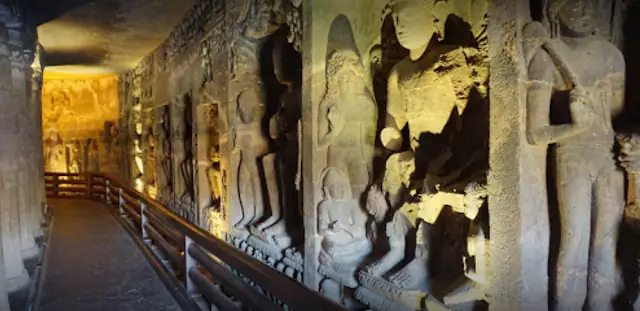
The caves of Ajanta and Ellora located in the Aurangabad district of Maharashtra, are located 100 kilometers away from each other, but due to their aesthetics and importance, the names of these two, are always taken together. Ajanta has 29 caves and there are 34 caves in Ellora. These caves made of cutting big mountains and rocks are a subtle example of Indian craftsmanship and architecture. Most of the caves in Ajanta’s caves are linked to Buddhism, whereas the architecture and sculptures present in Ellora caves are related to three different religions- Buddhism, Jainism, and Hinduism. Now, these caves are world heritage is being preserved so that the future generation can also see this excellent example of Indian art. The world-famous caves of Anjata have always been a major center for tourist attraction. The beautiful paintings and statues here are not less than a heaven for art lovers. The rocks of Haritima are wrapped, around the glory of this heritage of history hidden within it. Ganga rocks, greenery, beautiful statues, and the river Waghora which flows here, like the beauty of the beautifulness, gives its fullness.
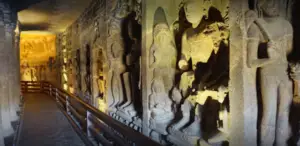
f you are fond of going around the world and are art lovers, then Anjata-Ellora is a great tourist destination for you. Nayab painting and sculpture made in the caves here are different in itself. Simultaneously, the caves here are a unique example of religious harmony.
About Ajanta caves-
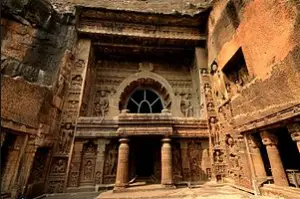
ajanta cave
Ajanta caves are situated, 101 km away from, Aurangabad and it is related to the third century, these ancient caves are nearly related to Buddhism, where you can see ancient artifacts on the walls of caves. These man-made ancient caves are known for its beautiful paintings. Also, it is, said about Lord Buddha’s past lives. You can visualize the past by visiting these caves. You may be surprised to know that Ajanta is not a two, but a group of 30 caves which is made by cutting the mountains in the shape of a horse cord and flows from its front, a narrow river named Vaghora. They have been, depicted in the Buddhist religion from 200 BC to 650 AD. In the Ajanta caves, beautiful pictures of beautiful nymphs and various currencies of princesses have been, carved on the walls which are very beautiful decorations of excellent paintings and sculptures. These 30 caves, located on the hills of Sahyadri, have about 5 prayer houses and 25 Buddhist monasteries. These caves were discovered by Army Officer John Smith and his team in 1819. When they came here to hunt, they saw a series of 29 caves queues and this cave became famous. These caves played an important role in the expansion of two religions of Buddhism, Heinan and Mahayana. It is believed, that these caves remained, a habitat for Buddhists and followers for a long time. You can easily see Buddhist architecture here too. You can come here for a better understanding of history and information. This is an ideal place for art lovers and those interested in the past.
About Ellora Caves-
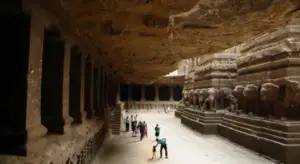
ellora cave
Like the Anjata, Ellora is also the ancient caves located in Aurangabad, which are known for its Buddhist, Hindu, and Jain structures. That is a World Heritage Site, where you can easily understand many critical aspects of the past. There are 34 monuments and temples in the caves of Ellora, which spread on the edge of the hill about two kilometers. These caves were constructed, between the 5th and 10th centuries. These caves came into existence from 350 to 700 AD. The Ellora caves are the choicest example of architecture built by cutting mountains and rocks. Most of the structures here are Vihar and Monuments. Among them, Buddhist Cave, which is called Vishwakarma Kev, is the most famous. You can also see Monolithic Kailash Temple built by cutting a single rock dedicated to Lord Shiva. It is believed that there, are more than 100 ancient caves on this site, out of which 34 have been opened for tourists, out o1f which 12 caves represent Buddhism, 17 Hindus, and 5 Jain religions. The statues of caves based on Buddhism get a clear glimpse of Buddha’s lifestyle. Seeing them, it seems as if Buddha sitting in meditation, still giving us the message of peace, harmony, and unity. It is believed that these caves were built during the period of Hindu dynasties. Through these caves, you can understand ancient Indian art culture very nearly.
Amazing, history, Famous Fun Facts About Ajanta and Ellora caves For Tourists and Kids
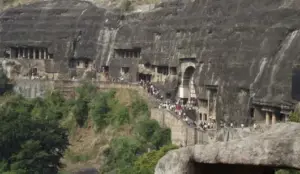
ajanta & ellora caves facts
Ajanta’s cave –
12 mysterious caves of India! The world-famous caves of Anjata have always been a significant center for tourist attraction. So, let’s go to this unusual creation of Maharashtra today and know, some interesting information related to it.
- Ajanta Caves has been included in the list of India’s global heritage by UNESCO since 1983. It is also one of the other monuments preserved by Archaeological Survey of India.
- Ajanta caves are 2000 years old and the Buddha’s effigy is about 600 years old.
- The discovery of the Ajanta caves was done in 1819 AD by an Army officer working in the Madras Regiment, of the British Army.
- Ajanta’s puzzle will show you a big picture of Buddha in the cave. The entrance, of the cave, is very beautifully decorated.
- It is believed that Ajanta caves have already existed in the Christian era. The oldest cave here, No. 10 will take you directly in the second century BC.
- In addition to the beautiful paintings and grand statues, the big pillars, the statues of Buddha, the sealing peaked picture gives a new record to the cave of Ajanta and attracts the tourists.
- Ajanta caves are a group of caves made by cutting 30 stones, which are proudly represented by former intellectual architecture, sculptures and cave paintings.
- After examining the cave and investigating the investigation, it was discovered that there are about 30 caves in Ajanta’s cave and these caves were in two parts, many of which happened in the Satavahana period and many Waqata periods.
- The sculptures and other creations of these caves have been produced by Buddhist monks, who have been shown stories by carving using ordinary tools like hammers and chisels.
- In the life of Buddha, he was against making his paintings and maps in the cave.
- The main themes of the carvings here are connected to the living character of Gautam Buddha. They also show Buddhist philosophy and teachings of Buddha.
- The second phase was constructed in the kingdom of Harishena Wakataaka ruler. In this period, temples were built in close caves.
- Due to the thick forest, Harisena’s ruler had ceased to be a cave and the people forgot it.
- In the pictures of Ajanta caves, you can see the strong influence of the artistic style of Tibet and Sri Lanka. Glue has been used to connect most of the pictures to each other.
- The maps and images of Ajanta’s caves were heavily influencing the teachings of the Buddha, for which many paintings of the Royal Court were made.
- In the Mahayana Hinayana period, two Chaitya Ghars were found, which were in Cave 9 and 10. The cave numbers of this phase are 12, 13, 15 viharas.
- Ajanta caves are excavated, located along the Waghora River, the horse-shaped rock-shaped rock has been excavated.
- In the monsoon season, Ajanta caves were used as a shelter by Buddhist monks.
- Ajanta Caves are the most famous for their impressive graffiti and many other paintings all over the world, who have given their full support to the world art and are also, regarded as the treasure of ancient Indian art.
- British researcher Mr. Griffith says, “The painters who painted in Ajanta were the peak of creation.” The vertical lines drawn on the walls in Ajanta are easily drawn, from Kuchi, they are amazed.
- This is a wonderful creation. But when the surface of the roof is parallel to the horizon, the corresponding rotation, the appearance of uniformity in the shape of the arches, and focuses on thousands of complexities of its creation, then it seems to be an excellent wonder and a miracle.
- The cave of Ajanta 9, 10, 12, 13 15a (the last cave was discovered in 1956 and the number has not been counted.) Was discovered at this stage. In these excavations, Buddha has been shown as a stupa or a monastery.
- After, examining the cave and investigating the investigation, it was discovered that there are about 30 caves in Ajanta’s cave and these caves were in two parts, many of which happened in the Satavahana period and many Waqata periods.
- Ajanta’s Cave 2’s door, roof and temple carvings are amazing. There are 1000 images of Lord Buddha on the walls of these caves. In the corridor, there is a little girl who is called a revolving girl, this picture puts light on the physical energy of the Buddha.
- In cave 26, the center of attraction, the miracle of Shravasti, the family group, and the curly hair Buddha are pictures of God’s head. Shravasti was a village, where people living in them considered themselves fortunate because they had seen Mahatma Buddha. The family group painted in this cave was considered to be an ideal family of that time and the face of God reflects his spiritual progress.
- Due to being situated, in a dense forest, the Cave created in Harisena’s Rule was stopped and the people forgot it.
- The Ajanta caves have the latest features, the sidewalls, the doorsteps, and the sacred sites in the courtyard are also seen. The walls of many buildings are decorated with carvings, wall paintings on walls and terraces.
Ellora Cave –
- There are caves of Ellora 30 km away from Aurangabad. The caves of Ellora include 34 caves. In this cave, the influence of Triveni Sangam of the faith shown towards Hinduism, Jainism, and Buddhism is found, in three religions. These caves came into existence from 350 to 700 AD.
- The cave of Ellora is also known as Veerul’s lane.
- From the cave of Ellora, The Great Cillesa Cave is the largest cave there.
- According to archaeologists, it was made at least 4,000 years ago.
- Ellora is famous for the largest, single monolithic excavation in the world, the huge Kailash (cave 16). It is said that the construction of this cave was done by Krishna, the ruler of Rashtrakutas first. This multi-story cave temple is dedicated, to the Kailash temple, Lord Shiva’s house.
- Ellora Caves Not only this cave complex is a unique artistic creation, but it is also a classic example of technology use. But it has been dedicated to Buddhists, Hindus and Jains religion for centuries. These reflect the spirit of tolerance, which has been characteristic of ancient India.
- Cave no 10, God of creation or creation, is devoted to Lord Vishwakarma, hence this cave is called Vishwakarma Cave. Inside the cave, Lord Buddha’s 15-feet statue sits in the position of preaching. This unusual combination of two religions located in this cave is very rare.
- The caves here have been made by cutting volcanic basaltic structures of Maharashtra, which are called ‘Deccan Trap’.
- Here are the magnificent Jain caves which include the Indra Sabha, the Jagannath Sabha, and the small Kailash Caves, are the most famous and notable among the Jain caves located here. Their walls were decorated with very beautiful paintings and elaborate artworks.
- It is said that these caves were made with the help of aliens. Humans could not make them, nor did they have any technique like this. It is said that many Indian saints, could have talked to the world of aliens and the help of aliens was taken to create these caves. It is said that many Indian saints could have talked to the world of aliens and the help of aliens was taken to create these caves. The saint could call the aliens on earth and in this sequence, the aliens would have come here on earth and they would have done such great work while using their art.
- Due to the beautiful carvings and paintings carried on the walls of these caves, the caves were declared World Heritage Site by UNESCO in the year 1983.
- In the Dashavatara cave Ellora, the picture of the ten incarnations of Vishnu is made.
- The beginning of Rameshwar, the Goddess of the river Ganga enhances the beauty of the Yamuna.
- The world’s most beautiful stones and in the middle of the 5 to 10 century.
- Dhumar Lena and Cave Temple Elephanta Diwap are like Mumbai.
- Alora has about 100 caves, of which only 34 caves have been opened for tourists.
- In these caves 34, monastery and temple 2 km near Aurangabad. Are spread in the area of.
- Kalasugah Temple built by Rashtrakutas ruler Krishna-I is the most outstanding.
- In Ellora, the temples and monasteries within the caves have been constructed by cutting large 2 hills into the vertical portion, which is 26 kilometers north of Aurangabad.
- These caves are at the edge of Basaltic’s hillside.
- These caves contain many stairs, doors, windows, and statues, with a detailedly carved stone pillar and hall.
- The temples built here are designed to carve the carvings on the monasteries with chisels and hammer.
- The statues of caves based on Buddhism get a clear glimpse of Buddha’s lifestyle.
- In the 16th cave, artisans, and sculptures like Kailash Temple, made by cutting a large hill, you will hardly find a glimpse.
- The specialty of the Ellora cave, unlike Ajanta caves, is that they are never expected to be located near the trade route.
How to Enter in Ajanta-Ellora cave :
- The distance of Ajanta from Aurangabad – 101 km
- Distance from Aurora to Ellora – 30 kilometers
Ajanta Caves, 100 km from Aurangabad city of Maharashtra and Ellora Caves, are located 30 km away. You can reach these caves with the help of bus or private traffic from Aurangabad. Here is the nearest airport to Aurangabad Airport, you can take the help of Aurangabad railway station for the railway route. If you want, you can also reach here by road, Aurangabad is well related to the big cities of the state with safer roads.
Search Posts
Latest posts
-
5 Mar, 2024
Passing through airport security with autism
-
4 Mar, 2024
How to make dining alone less awkward?
Popular posts
-
5 Mar, 2024
Why prohibit engine braking?